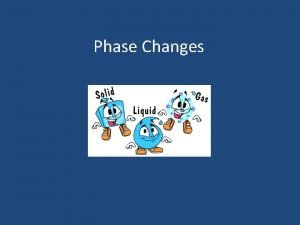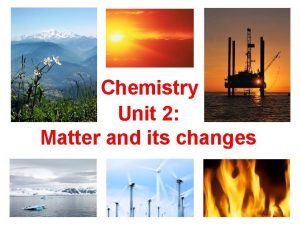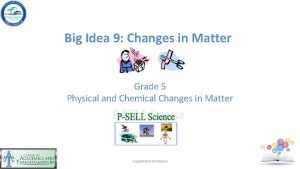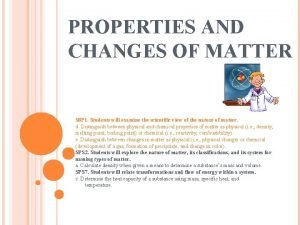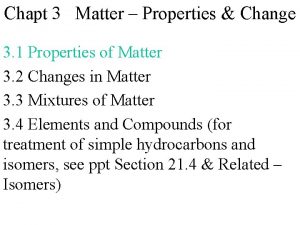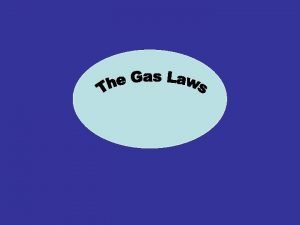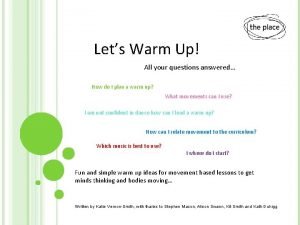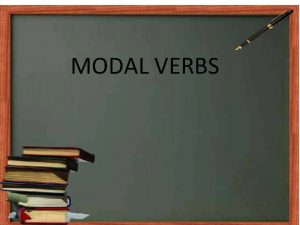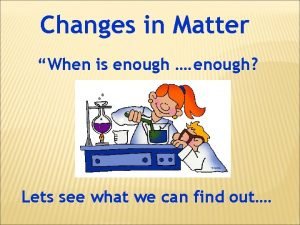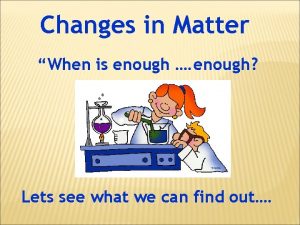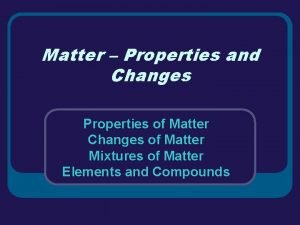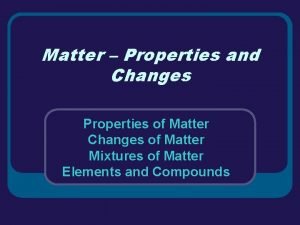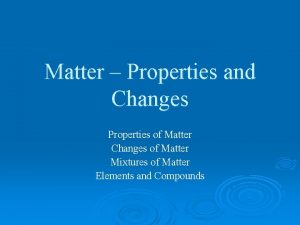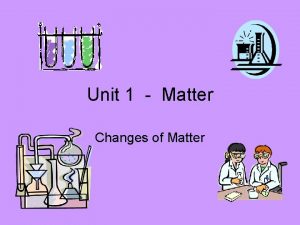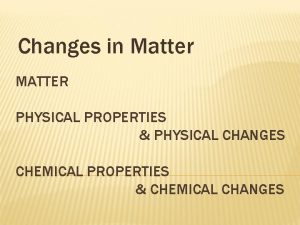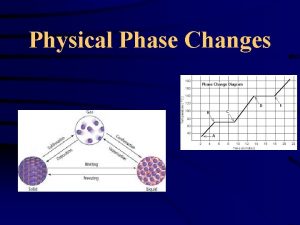Changes in Matter When is enough enough Lets























































- Slides: 55

Changes in Matter “When is enough …. enough? Lets see what we can find out….

Matter and its changes Substances and mixtures Changes in Matter

THE NATURE OF MATTER Matter is anything that takes up space and has mass. The word matter comes from the Latin word materia, meaning “material” or “stuff” First we need Examples of Matter : to ask. . . What is matter? You can observe matter easily with your senses…. . rock, trees, bicycles, air…. Basically everything and anything! The only thing that wouldn’t be matter would be energy (sunlight, heat, electricity). - no mass or volume so they can’t be matter!

MATTER EVERYTHING IS MADE OF MATTER! Matter= anything that has volume and mass

REMEMBER Volume= amount of space taken up, or occupied by an object. (L X H X W) Mass= is the amount of matter in an object

MASS & WEIGHT: WHAT’S THE DIFFERENCE? Weight is different from mass and involves gravity Weight= a measure of the gravitational force exerted on an object Gravity= a force of attraction between 2 objects due to their masses and distance between them Close together, weighs a lot= MORE attraction Far apart, weighs a little= LESS attraction

DO WE WEIGH THE SAME ON EVERY PLANET? NO! Each planet has a different value of gravity

MASS VS WEIGHT MASS (GRAMS) A measure of the amount of matter in an object Always constant for an object no matter where the object is in the universe Measured with a triple beam balance Usually in kg, g, and mg WEIGHT (NEWTONS) A measure of the gravitational force on an object Varied depending on where the object is in relation to the Earth Measured with a spring scale Usually in Newtons (9. 8)

PHYSICAL PROPERTIES: DENSITY Density= the amount of matter in a given space Density= mass = m volume v Units for density are g/cm 3, g/m. L, kg/m 3, kg/L **MEMORIZE: Liquid water has a density of 1. 0 g/cm 3

PHYSICAL PROPERTIES: DISPLACEMENT Thank you Archimedes!

BOUYANCY: DISPLACEMENT 100, 000 TONS

Density is useful Density of a particular substance is ALWAYS the same at a given pressure and temperature. NO MATTER THE SIZE OR SHAPE, DENSITY DOESN’T CHANGE! Example: aluminum foil has the same density as aluminum can. Density of one substance is usually different from another substance. Example: solid copper has a density of 8. 96 g/cm 3 solid silver has a density of 10. 50 g/cm 3

Physical Properties of Matter Density of a substance is the ratio of its mass compared to its volume. Density= the amount of matter in a given space Density= mass = m volume v Units for density are g/cm 3, g/m. L, kg/m 3, kg/L **MEMORIZE: Liquid water has a density of 1. 0 g/cm 3

Elements, Molecules, and Compounds Elements and compounds make up all the different kinds of matter in the universe. Elements are the simplest form of matter Cannot be broken down into simpler substances. Six elements make up: 99% of all living matter! Examples of Elements n Each element is made of atoms of the same type. • Sulfur • Nitrogen ün Each gold has a unique ü aluminum set of physical and chemical • Potassium • Carbon properties. ü silver ü nitrogen • n. Oxygen • Hydrogen 117 known elements in the universe. ü oxygen ü tin n Approximately 92 are found naturally on Earth. ü hydrogen ü calcium n

Compounds, Molecules, and Elements Compounds are two or more elements combined chemically together. n n Properties are different from the properties of the elements that make them up. Elements in a compound have a fixed ratio. Example: Hmatter O Cl 2 universe = Water Salt ++ in the Most. Na is in the (oxygen) (hydrogen) (Sodium) (chlorine) form of compounds! Explosive Soft metal explodes gas in H 2 0 Explosive Poisonous gas greenish

Molecules, Elements, and Compounds When two or more atoms combine, they form a molecule. n n Most molecules are made of two or more atoms A molecule is the smallest particle of a substance with the same properties of the substance. NOTE: Compounds are different than molecules because compound is used to describe the substance in general, while molecule describes the smallest particle of the substance.

Mixtures, Solutions, and Suspensions A mixture is a combination of two or more substances NOT combined chemically. May be a mixture of both elements and compounds n Substances keep their unique properties and can be separated by physical means. n

Mixtures, Solutions, and Suspensions There are two types of mixtures. . . Heterogeneous – the parts of the mixture are noticeably different from one another. Homogeneous – the parts (substances) are evenly distributed. It is difficult to tell one substance from another.

Solutions, and Suspensions and Colloids A solution is a mixture that looks like a single substance and has the same properties throughout. Solute ~ The substance that dissolves in a solution. Solvent ~ The substance into which the solute dissolves.

Solutions, and Suspensions and Colloids A colloid is a mixture that contains both small particles in solution and larger particles in suspension. • Colloids do not separate into layers. • Colloids, like suspensions scatter light. Milk is an example of a colloid. In a suspension components are dispersed, but large enough to see and settle out.

Properties of Matter Physical Properties

Physical Properties Physical property is a property that can be observed without changing the identity of the substance. Examples: ü viscosity ü conductivity ü malleability ü hardness ü magnetism ü melting point ü boiling point ü density ü color

Physical Properties of Matter Viscosity of a substance is its resistance to flow. Examples: water = low viscosity honey = high viscosity

Physical Properties of Matter

Physical Properties of Matter Conductivity is a material’s ability to allow heat to flow. Examples: metal = high conductivity wood = poor conductivity

Physical Properties of Matter Malleability of a substance is its ability to be hammered into a thin sheet

States of Matter We are going to look at five states of matter. Solids, liquids, gases, plasmas, and Bose-Einstein condensates (BEC) are different states that have different physical properties. Each of these states is also known as a phase. Elements and compounds can move from one phase to another when specific physical conditions change.

States of Matter Think about it this way. Let’s say you have a glass of water (H 2 O). When the temperature of the water goes up, the molecules get more excited and bounce around a lot more. If you give a liquid water molecule enough energy, it escapes the liquid phase and becomes a gas.

States of Matter "Phase" describes a physical state of matter. The key word to notice is physical. Things only move from one phase to another by physical means. If energy is added (like increasing the temperature) or if energy is taken away (like freezing something), you have created a physical change.

States of Matter When molecules move from one phase to another they are still the same substance. There is water vapor above a pot of boiling water. That vapor (or gas) can condense and become a drop of water in the cooler air. If you put that liquid drop in the freezer, it would become a solid piece of ice. No matter what physical state it was in, it was always water. It always had the same chemical properties.

States of Matter Imagine that you are a solid. You're a cube of ice sitting on a counter. You dream of becoming liquid water. You need some energy. Heat is probably the easiest energy you can use to change your physical state. The atoms in a liquid have more energy than the atoms in a solid. There is a special temperature for every substance called the melting point. When a solid reaches the temperature of its melting point, it can become a liquid. For water, the temperature needs to be a little over zero degrees Celsius (0 o. C) for you to melt. (32 degree Fahrenheit)

Physical Properties of Matter Melting and Boiling points are the temperatures at which a solid becomes a liquid and a liquid becomes a gas. If you were salt, sugar, or rock, your melting point is higher than that of water. How do you know that fact?

Physical Properties of Matter Liquid to Gas and Back to Liquid When you are a liquid and want to become a gas, you need to find a lot of energy. Once you can direct that energy into your molecules, they will start to vibrate. If they vibrate enough, they can escape the limitations of the liquid environment and become a gas. When you reach your boiling point, the molecules in your system have enough energy to become a gas.

Physical Properties of Matter Liquid to Gas and Back to Liquid The reverse is true if you are a gas. You need to lose some energy from your very excited gas atoms. The easy answer is to lower the surrounding temperature. When the temperature drops, energy will be transferred out of your gas atoms into the colder environment. When you reach the temperature of the condensation point, you become a liquid. If you were water vapor over a boiling pot of water and you hit a wall, the wall would be cool, absorb some of your extra energy, and you could quickly become a liquid. Cooler objects often absorb energy from hotter objects.

Physical Properties to separate mixtures Two common separation methods: Filtration – process that separates materials based on the size of their particles. Distillation – process that separates the substances in a solution based on their boiling points.

Properties of Matter Chemical and physical changes are related to chemical and physical properties.

Properties of Matter Physical Changes Physical changes are concerned with energy and states of matter. A physical change does not produce a new substance, although the starting and ending materials may look very different from each other. Changes in state or phase (melting, freezing, vaporization, condensation, sublimation) are physical changes.

Properties of Matter Chemical Changes Chemical changes take place on the molecular level. A chemical change produces a new substance. Another way to think of it is that a chemical change accompanies a chemical reaction.

Physical Change A change in the appearance, without changing the composition of the material. It is a physical change if. . . • Can be reversible, or irreversible • üü Substance seem different, the dissolves. Itchanges shape or changes size but phase. ü Or themay substance way the atoms link up is the same.

Physical Change A change in the appearance, without changing the composition of the material. https: //www. youtube. com/watch? v=k. L 5 x. GQUi. Ax. Q

Physical Change A change in the appearance, without changing the composition of the material. Examples of Physical Changes crumpling a sheet of aluminum foil breaking a bottle melting an ice cube boiling water casting silver in a mold evaporating alcohol shredding paper sublimation of dry ice into carbon dioxide vapor

Properties of Matter Chemical Properties

Chemical Properties Chemical property is any ability to produce a change in the composition of matter. Examples of chemical properties. . . flammability reactivity Material’s ability to burn in the presence of oxygen. How readily a substance combines chemically with other substances.

Chemical Changes Chemical changes occur when a substance reacts and forms one or more new substances. You know a chemical change has occurred when. . . ü A change in color. ü Production of a gas. ü Formation of a precipitate.

Chemical Changes Chemical changes occur when a substance reacts and forms one or more new substances. http: //www. youtube. com/watch? v=g. Cbqjs-pq. Jo

Chemical Changes Chemical changes occur when a substance reacts and forms one or more new substances. Examples of Chemical Changes burning wood baking a cake souring milk heating sugar to form caramel mixing acid and base cooking an egg digesting food

Chemical Changes Vs Physical Changes Physical changes are usually about physical states of matter. Chemical changes happen on a molecular level when you have two or more molecules that interact. Chemical changes happen when atomic bonds are broken or created during chemical reactions.

Chemical Changes Vs Physical Changes Physical changes are usually about physical states of matter. Chemical changes happen on a molecular level when you have two or more molecules that interact. Chemical changes happen when atomic bonds are broken or created during chemical reactions.

Chemical Changes Vs Physical Changes How to Tell Whether It's a Physical or Chemical Change? Look for an indication that a chemical change occurred. Chemical reactions release or absorb heat or other energy or may produce a gas, odor, color or sound. If you don't see any of these indications, a physical change likely occurred. In some cases, it may be hard to tell whether a chemical or physical change occurred. For example, when you dissolve sugar in water, a physical change occurs. The form of the sugar changes, but it remains the same chemically (sucrose molecules). However, when you dissolve salt in water the salt dissociates into its ions (from Na. Cl into Na+ and Cl-) so a chemical change occurs. In both cases a white solid dissolves into a clear liquid and in both cases you can recover the starting material by removing the water, yet the processes are not the same

WHAT KIND OF CHANGE IS IT? physical

WHAT KIND OF CHANGE IS IT? chemical

WHAT KIND OF CHANGE IS IT? physical

WHAT KIND OF CHANGE IS IT? physical

WHAT KIND OF CHANGE IS IT? chemical

WHAT KIND OF CHANGE IS IT? physical
 How much vs how many
How much vs how many And doggone it i'm good enough
And doggone it i'm good enough Our failing schools enough is enough summary
Our failing schools enough is enough summary Our failing schools enough is enough
Our failing schools enough is enough Example of chemical change
Example of chemical change Changes in latitudes, changes in attitudes meaning
Changes in latitudes, changes in attitudes meaning Phases changes of matter
Phases changes of matter Two types of changes
Two types of changes Changes in matter concept map
Changes in matter concept map Chemistry matter and its changes
Chemistry matter and its changes Properties of and changes in matter grade 5
Properties of and changes in matter grade 5 Properties and changes of matter worksheet
Properties and changes of matter worksheet Matter-properties and changes answer key
Matter-properties and changes answer key Phase changes of matter
Phase changes of matter True or false: chemical and physical changes alter matter.
True or false: chemical and physical changes alter matter. Chemical properties of air
Chemical properties of air Change in state of matter
Change in state of matter Condensation phase change
Condensation phase change Section 1 composition of matter
Section 1 composition of matter Gray matter and white matter
Gray matter and white matter Chapter 2 section 1 classifying matter answers
Chapter 2 section 1 classifying matter answers Frontal and parietal lobes
Frontal and parietal lobes Section 1 composition of matter
Section 1 composition of matter Brain falx
Brain falx Energy naturally flows from warmer matter to cooler matter
Energy naturally flows from warmer matter to cooler matter White matter of brain
White matter of brain Composition of matter section 1
Composition of matter section 1 7 horse optical illusion answer
7 horse optical illusion answer Practice task 1 guess what
Practice task 1 guess what Davion ferguson
Davion ferguson Lets play bridge
Lets play bridge Lets fight it together
Lets fight it together Lets see what you already know
Lets see what you already know Tissue imtiaz dharker
Tissue imtiaz dharker Let's make waves
Let's make waves Let's think in english
Let's think in english Lets engage
Lets engage Describe the person in the picture
Describe the person in the picture Plan let's go
Plan let's go Just a quick recap of what we discussed
Just a quick recap of what we discussed Slogan let's make things better
Slogan let's make things better Lets see what you know
Lets see what you know Lets get started images
Lets get started images Icivics we're free let's grow answer key
Icivics we're free let's grow answer key Let's warm up together
Let's warm up together Let's review cartoon
Let's review cartoon Modal verbs for requests
Modal verbs for requests Lets play jeopardy
Lets play jeopardy Lets play
Lets play Let's teach library
Let's teach library Lets do the rooms
Lets do the rooms Clean together
Clean together Intergers
Intergers Lets answer the questions
Lets answer the questions Let's learn python
Let's learn python Lets be copd
Lets be copd






